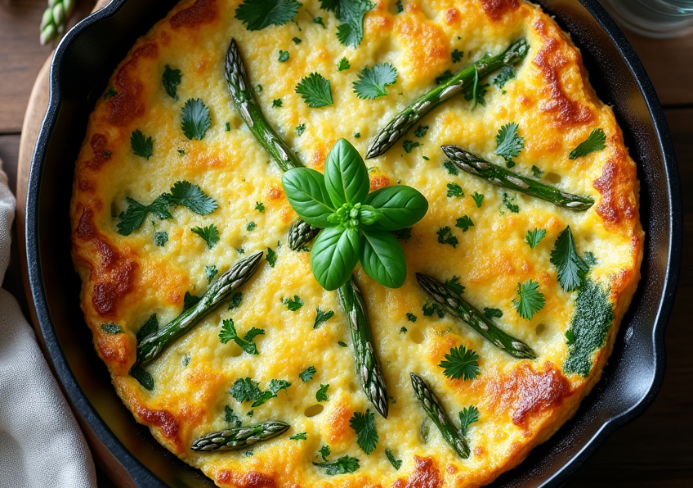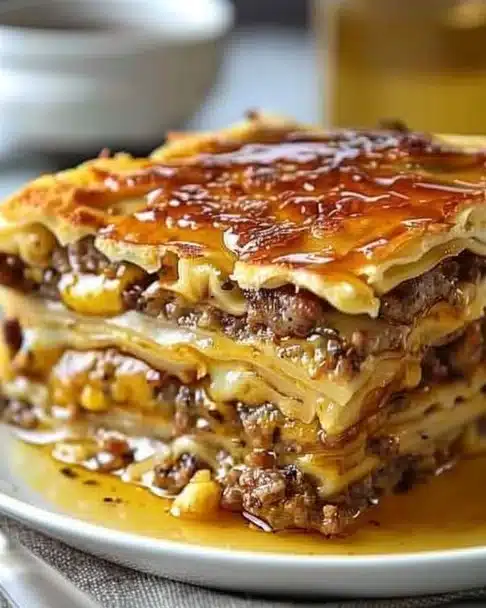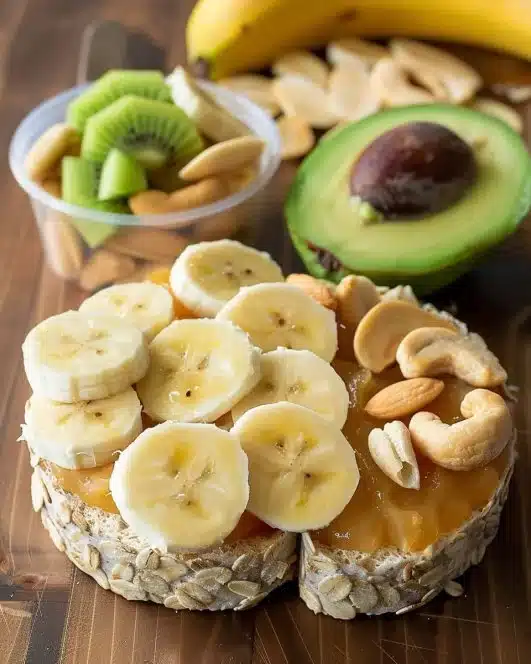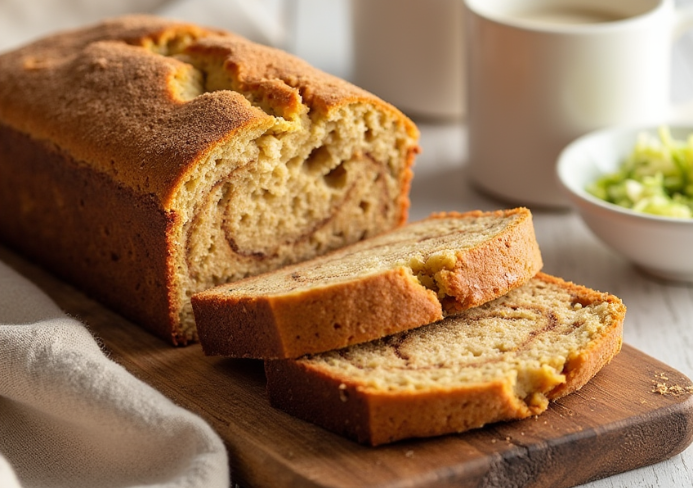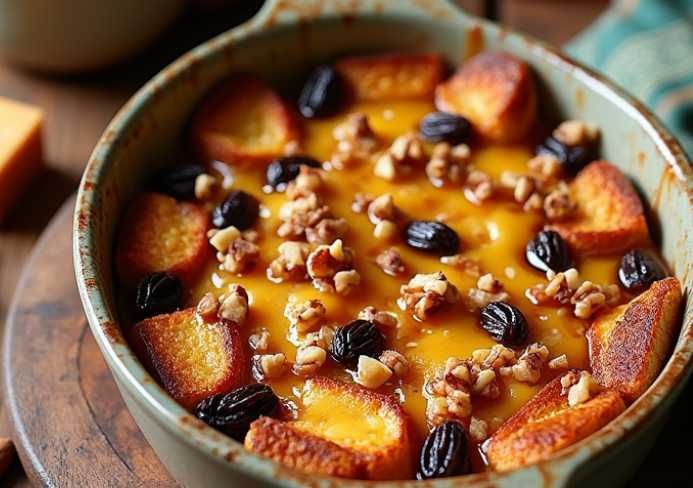Elegant Asparagus and Cheese Frittata | Vegetarian Recipes
Introduction to Elegant Vegetarian Brunches
Table of Contents
There’s something undeniably charming about a beautifully made frittata—golden on the outside, tender on the inside, and bursting with fresh flavor. For vegetarians and brunch lovers alike, the asparagus and cheese frittata delivers elegance with minimal effort.
With the rise of health-conscious and plant-based diets, the demand for protein-rich vegetarian recipes has never been higher. And what better way to satisfy that craving than with a dish that balances fresh seasonal vegetables, rich cheese, and farm-fresh eggs in one pan?
What is a Frittata?
A frittata is an Italian egg-based dish, similar to an omelet or crustless quiche, but with one key difference—it’s cooked slowly and often finished in the oven. Unlike quiches that use a pastry crust and cream, frittatas are lower in carbs and higher in versatility. They make ideal meals for breakfast, brunch, or even dinner.
While you can customize frittatas endlessly, the combination of asparagus and Parmesan cheese is particularly refined. According to Harvard’s Nutrition Source, eggs are a complete protein and a healthy staple when prepared simply. Combined with nutrient-packed asparagus, this dish becomes a wholesome centerpiece.
For vegetarians looking for guidance on balancing their diet, the Vegetarian Society’s meal planning guide offers great insights into maintaining variety and nutrition without meat.
Ingredients Breakdown
Here’s what you’ll need to make this elegant asparagus and cheese frittata:
- 8 large eggs – the foundation of your dish, offering high-quality protein
- ½ pound fresh asparagus – trimmed and cut into 1-inch pieces
- ½ cup grated Parmesan cheese – adds rich, umami flavor
- 7 tablespoons milk – helps keep the texture tender
- Salt and black pepper – to taste
- 1 tablespoon olive oil + 2 teaspoons butter – for sautéing
- Optional: chopped parsley, basil, or dill for garnish
Optional Enhancements:
- Add ¼ cup chopped onions or scallions
- Swap in cheeses like Gruyère, aged cheddar, or feta
- Include vegetables such as spinach, mushrooms, or tomatoes

Tools and Kitchenware Needed
To keep the cooking process seamless, gather the following:
- Non-stick skillet (9-inch preferred)
- Mixing bowl and whisk
- Heat-resistant spatula
- Optional: oven-safe pan for broiler finishing
Step-by-Step Cooking Instructions
Follow these steps for a perfectly cooked, elegant frittata:
- Prep the asparagus: Trim and cut into bite-sized pieces.
- Heat oil and butter in a non-stick pan over medium heat. Sauté the asparagus for 10–15 minutes until soft but still firm.
- Whisk the eggs in a bowl until frothy. Mix in the Parmesan cheese, milk, salt, and pepper.
- Pour the egg mixture evenly over the asparagus in the pan.
- Cook on medium-low heat until the edges set and the top remains slightly runny (around 10–15 minutes).
- If the center remains uncooked, cover the pan with a lid or transfer to a preheated oven at 375°F for 5–7 minutes.
- Garnish with chopped herbs before serving.
Tips for Elegance & Flawless Texture
- Use duck eggs for an even richer texture.
- Mix heavy cream with milk for a luxurious mouthfeel.
- Garnish with microgreens, shaved truffle, or edible flowers for elevated presentation.
- Ensure even cooking by reducing heat or covering with a lid.
Nutritional Benefits of the Dish
This frittata isn’t just delicious—it’s also packed with nutrients:
- Eggs offer essential amino acids, vitamins B12 and D, and iron.
- Asparagus provides fiber, folate, and vitamins A, C, and K.
- Cheese adds calcium and beneficial fats.
The dish is naturally low-carb, gluten-free, and easily adaptable for various dietary needs.
Vegetarian Variations to Explore
Want to customize your frittata even more? Try these variations:
- Vegan option: Use a tofu base, unsweetened plant milk, and nutritional yeast for a cheesy flavor.
- Cheese swaps: Try Gouda, mozzarella, or goat cheese for different textures and flavor profiles.
- Vegetable alternatives: Use zucchini, bell peppers, or broccoli depending on what’s in season.
For cheese combinations that work beautifully in savory dishes, check out this cheese pairing guide by Bon Appétit.
How to Serve Your Asparagus and Cheese Frittata
Serve your frittata warm or room temperature with:
- A side of peppery arugula salad or roasted potatoes
- A slice of toasted sourdough bread
- A brunch cocktail like a mimosa or virgin Mary
Garnish with chopped herbs, edible flowers, or a sprinkle of extra cheese for added flair.
Storing and Reheating Instructions
Make your frittata ahead or save leftovers:
- To store: Let cool completely, then refrigerate in an airtight container for up to 3 days.
- To freeze: Slice into portions, wrap individually, and freeze for up to 2 months.
- To reheat: Warm slices in a skillet over low heat or microwave in 30-second bursts.
Avoid overcooking when reheating to maintain the tender texture.
FAQs Based on People Also Ask
What is the difference between quiche and frittata?
A quiche includes a pastry crust and usually cream, while a frittata is crustless and cooked on the stovetop or oven.
Can I bake my frittata instead of using the stovetop?
Yes! Simply pour the mixture into an oven-safe dish and bake at 375°F for 20–25 minutes.
What other vegetables go well in a frittata?
Try spinach, mushrooms, zucchini, bell peppers, or even leftover roasted vegetables.
Can I make this recipe ahead of time?
Absolutely. Cook and refrigerate the frittata, then reheat just before serving.
What cheese is best for frittata?
Parmesan, cheddar, goat cheese, Gruyère, and feta are all excellent options.
Is asparagus healthy to eat frequently?
Yes. It’s low in calories and high in fiber, vitamins, and antioxidants.
Can I make this frittata without dairy?
Yes. Use non-dairy milk (like oat or almond) and skip the cheese or use vegan alternatives.
Final Thoughts & Recipe Summary
The elegant asparagus and cheese frittata is more than just a meal—it’s a statement of flavor, texture, and sophistication in a simple skillet. Whether you’re preparing brunch for guests or a quick dinner for yourself, this vegetarian classic never fails to impress.
Explore different ingredients, play with presentation, and make it your own. Bon appétit!
PrintElegant Asparagus and Cheese Frittata | Vegetarian Recipes
- Total Time: 30 minutes
- Yield: 4 servings
Description
An elegant and nutritious asparagus and Parmesan frittata, perfect for brunch or a light dinner. This dish pairs tender sautéed asparagus with fluffy eggs and rich cheese for a refined, protein-packed meal.
Ingredients
- 8 large eggs
- ½ pound fresh asparagus, trimmed and cut into 1-inch pieces
- ½ cup grated Parmesan cheese
- 7 tablespoons milk (dairy or non-dairy)
- Salt and black pepper, to taste
- 1 tablespoon olive oil
- 2 teaspoons butter
- Optional garnishes: chopped parsley, basil, or dill
- Optional enhancements: ¼ cup chopped onions or scallions, Gruyère, aged cheddar, or feta cheese, spinach, mushrooms, or tomatoes
Instructions
- Prepare asparagus: Trim and cut the asparagus into 1-inch bite-sized pieces.
- Sauté: Heat olive oil and butter in a 9-inch non-stick skillet over medium heat. Sauté asparagus for 10–15 minutes until tender but still firm.
- Whisk eggs: In a mixing bowl, whisk the eggs until frothy. Add Parmesan cheese, milk, salt, and pepper.
- Combine: Pour the egg mixture over the asparagus in the skillet. Cook on medium-low heat until the edges are set but the center is slightly runny, about 10–15 minutes.
- Finish cooking: If the center is not fully set, cover the pan with a lid or transfer to a 375°F (190°C) oven for 5–7 minutes until fully cooked.
- Garnish and serve: Sprinkle with fresh herbs like parsley or dill before serving warm or at room temperature.
Notes
For added depth of flavor, sauté onions or mushrooms with the asparagus. Swap in your favorite cheese like feta or Gruyère. This frittata can also be served chilled or reheated for meal prep.
- Prep Time: 10 minutes
- Cook Time: 20 minutes
- Category: Brunch / Light Meal
- Method: Stovetop and optional oven finish
- Cuisine: Mediterranean-inspired

